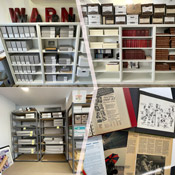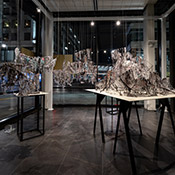
MSO Partners with Artist Reggie Baylor
David Lewellen
PUBLISHED
Tagged Under: 2022.23 Season, Around Town, Partners
If you ask Reggie Baylor for an artwork that will match your sofa, he will not say, “Begone, Philistine.” He will say, “What does your sofa look like?”
The well-established Milwaukee artist was commissioned to create the image of the Bradley Symphony Center that decorates much of the Milwaukee Symphony’s promotional material this season. And as usual for his work, it was a collaboration.
“There’s a level of trust” when someone pays for a new work, Baylor said. “Usually the client has seen some work previously, and we try to figure out what about the previous work they like and pull that into something new.” He worked with his creative director, Melissa Courtney, and two MSO staffers to develop the final image.
The work was originally commissioned several years ago by the Young Presidents’ Organization (YPO) Forum as a gift for Andy Nunemaker, the MSO’s immediate past board chair. A print now hangs in Nunemaker’s home, but he also used the image for his personal greeting cards. And when Executive Director Mark Niehaus received one, he got an idea.
Niehaus recognized Baylor’s style immediately, since he’s been a fan of the artist’s work for decades. “It makes the building look so alive, and I love Reggie’s work, so that was a number of things I love being connected,” he said.
The symphony then set up a licensing arrangement with Baylor to use the artwork for its promotional material this season in different permutations – such as using only part of the picture or altering the colors. “I would never want to change someone’s work of art, but Reggie likes that,” Niehaus said. “He likes to let his art go and see what people do with it.”
In part to shake the mystique of “art,” Baylor prefers to call his work “design.” “Design is more inclusive,” Courtney said. “Houses, cars, fashion – those are all designed. We enjoy collaborating with clients. It’s not just ideas in our own head.” Most of what he does now results from commissions, and he works with clients to create something they like.
Licensing or reproducing is also central to Baylor’s business model and helps his work to be seen more widely. “The labor that’s invested in an original canvas is tedious and expensive, and then it goes to one buyer,” he said. “Licensing work is a wonderful concept. It’s perfect for anyone in design, architecture, music, any intellectual property.”
Baylor was born and raised in Milwaukee, went to UW-Oshkosh and studied sculpture, but eventually switched to painting, partly because that took up less room in a small apartment. He worked for some years as a truck driver, but he became a full-time artist, working in southern California before moving back to Milwaukee in 1996.
In Milwaukee, and everywhere else, “social media has opened up who’s doing what,” Baylor said. “There are no obstacles to creating artwork. Finding or growing an audience for your work is a completely different story.”
But Baylor has been successful merging the creative skills of art and the analytical skills of business. Being an independent truck driver taught him some things about being an independent artist. “It’s a little less about self-expression versus being a service,” he said. “Studios have always looked for how to serve a patron or a client.”
His studio, on the 25th floor of a luxury apartment building in downtown Milwaukee, has a spectacular view, high, airy ceilings, access to a bar and a pinball machine – and only two small cupboards of paints. His work always begins in digital form nowadays, and often ends there, too. Baylor and Courtney work on their laptops and keep regular office hours, interacting with residents as part of their arrangement with the building.
He hopes for a creative renaissance in Milwaukee and the Great Lakes region as a whole. “Creative movements historically start where you least expect them. Milwaukee in particular can have an impact on creative individuals nationally. In post-industrial cities, technology can scale creative products and services,” he said. “It requires complex design and collaborative discovery,” similar to the food and restaurant scene.
“Designs tell stories,” Courtney said. “We all rely on great content, and it requires working with the community, because the community owns the story.”
Could the performing arts, like the symphony, be part of that renaissance? “That’s the dream,” said Courtney.
“I get goosebumps thinking about it,” said Baylor.



